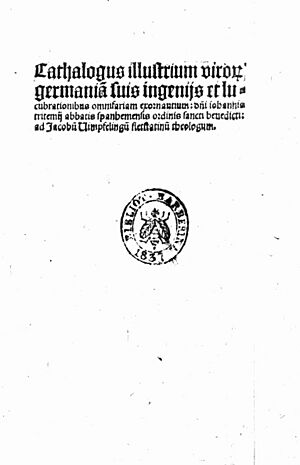Johannes Trithemius facts for kids
Quick facts for kids
Johannes Trithemius
|
|
|---|---|
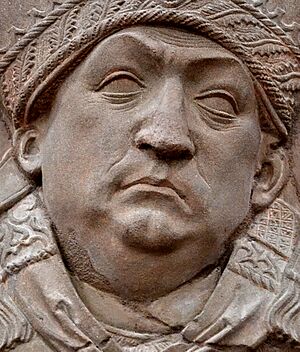
Detail of Tomb Relief of Johannes Trithemius by Tilman Riemenschneider
|
|
| Born | 1 February 1462 |
| Died | 13 December 1516 (aged 54) |
| Nationality | German |
| Alma mater | University of Heidelberg |
| Known for | Steganographia, Polygraphiae, Trithemius cipher |
| Scientific career | |
| Fields | Theology, cryptography, lexicography, history, occultism |
| Institutions | Benedictine abbey of Sponheim, St. Jakob zu den Schotten |
| Notable students | Heinrich Cornelius Agrippa Paracelsus |
Johannes Trithemius (1 February 1462 – 13 December 1516) was a German Benedictine abbot and a very smart person known as a polymath. He lived during the German Renaissance. He was active as a writer of dictionaries, a historian, a cryptographer (someone who writes secret codes), and an occultist (someone interested in hidden knowledge).
Many people think he started modern cryptography and steganography (hiding messages). He also helped create the study of books and writing. Trithemius had a big impact on how people thought about hidden knowledge in his time. Two of his famous students were Heinrich Cornelius Agrippa and Paracelsus.
Contents
Early Life and Learning
Johannes Trithemius was born Johann Heidenberg in a town called Trittenheim near the Moselle River. This is why he was called "Trithemius."
When Johannes was a baby, his father died. Seven years later, his mother remarried. His stepfather did not want Johannes to go to school. So, Johannes had to learn in secret, which was very hard. He learned important languages like Greek, Latin, and Hebrew.
At 17, he left home to find good teachers. He traveled to cities like Trier, Cologne, and Heidelberg. He eventually studied at the University of Heidelberg.
Becoming an Abbot and Historian
In 1482, while traveling home from the university, Johannes got caught in a snowstorm. He found shelter at the Benedictine abbey of Sponheim. He decided to stay there and, surprisingly, was chosen as the abbot (the head of the monastery) in 1483. He was only 21 years old!
Trithemius worked hard to make the Sponheim abbey a place of learning. He was known for building great libraries. Under his care, the abbey's library grew from about 50 books to more than 2,000!
He also wrote many books as a historian. He started with a history of Sponheim and later wrote a two-volume history of Hirsau Abbey. His writing was very good, but sometimes he added made-up parts to his stories. For example, he created imaginary sources and characters to make his historical accounts more exciting or to connect royal families to ancient heroes.
However, not everyone liked his ideas or his reputation as a "magician." Because of disagreements with the monks, he left Sponheim in 1506. He then became the abbot of St. James's Abbey in Würzburg, where he stayed until he died.
His Famous Students
Johannes Trithemius taught many important people. Two of his most famous students were:
- Heinrich Cornelius Agrippa (1486–1535): A German scholar who studied many subjects, including medicine and hidden knowledge.
- Paracelsus (1493–1541): A Swiss doctor, chemist, and astrologer.
The Legend of Faust
Trithemius was known for his interest in hidden knowledge, and some people even thought he could perform magic. He is linked to the famous Faust legend. This legend is about a man who makes a deal with the devil.
In 1507, Trithemius was the first person to write about a real person named Doctor Faustus. Trithemius wrote a letter criticizing Faust, saying he had poor skills and went against church teachings. Some scholars think Trithemius saw himself as a true expert in hidden knowledge, seeking to understand the universe without showing off.
A famous story connects Trithemius to Emperor Maximilian. In this tale, Trithemius supposedly used his skills to bring back the spirit of Maximilian's first wife, Mary of Burgundy, after she died. The emperor was amazed because the spirit looked exactly like Mary, even having a birthmark only he knew about. However, the experience upset Maximilian, and he told Trithemius never to do it again. This story later became part of the Grimms' Tales.
Steganographia: The Secret Book
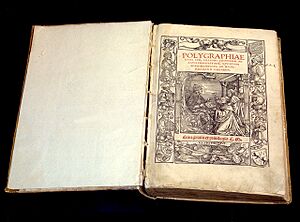
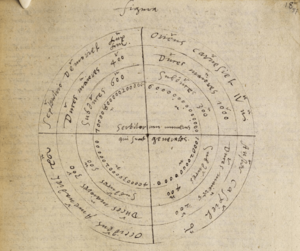
Trithemius' most famous book is Steganographia. He wrote it around 1499, but it was published much later in 1606. At first, people thought this book was about magic and using spirits to send messages over long distances.
However, when the secret code to the first two parts of the book was revealed in 1606, people realized it was actually about cryptography (secret writing) and steganography (hiding messages within other messages). Even the "magic" parts of the third volume were later found to be secret codes!
One of the codes in this book is called the Ave Maria cipher. In this code, each secret letter is replaced by a short Latin sentence about Jesus.
It's not fully known why Trithemius wrote Polygraphia and Steganographia as books that seemed to be about magic but were actually about codes. Maybe he wanted to attract attention to the topic of cryptography, which could be seen as boring.
Works by Trithemius
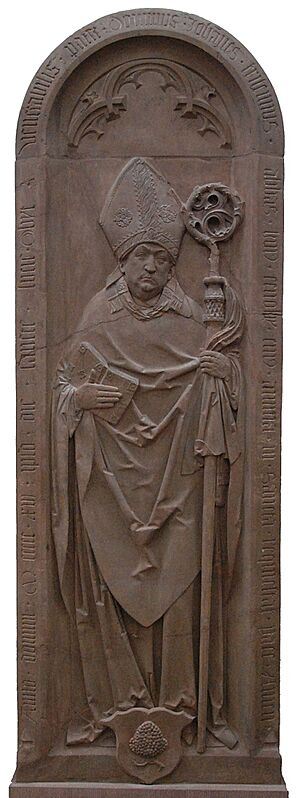
Trithemius wrote many books during his life. Here are some of his notable works:
- De institutione vitae sacerdotalis (1486) - About how priests should live.
- De laude scriptorum manualium (1492) - Praising the work of scribes who copied books by hand.
- Catalogus illustrium virorum Germaniae (1491–1495) - A list of famous German men.
- Chronicon Sponheimense (around 1495-1509) - A history of the Sponheim monastery.
- Steganographia (around 1499) - His famous book on secret writing.
- De septem secundeis (around 1508) - About seven "secondary intelligences" or spirits that move the planets.
- Polygraphia (written 1508, published 1518) - Another important book on codes and ciphers.
- Annales Hirsaugienses (1509–1514) - A long history of the Hirsau monastery, covering the history of France and Germany.
Death and Legacy
Johannes Trithemius died on December 13, 1516. He was buried in the church of St. James's Abbey in Würzburg. A beautiful tombstone made by the famous artist Tilman Riemenschneider was placed there to honor him.
His work in cryptography and steganography was very important. He is remembered as a key figure in the history of secret communication and for his vast knowledge in many different fields.
See also
 In Spanish: Johannes Trithemius para niños
In Spanish: Johannes Trithemius para niños
- Augustus the Younger, Duke of Brunswick-Lüneburg
- Humanism in Germany
- Minuscule 96 – written by the hand of Trithemius
- Tabula recta
- Trithemius cipher
- Theban alphabet


